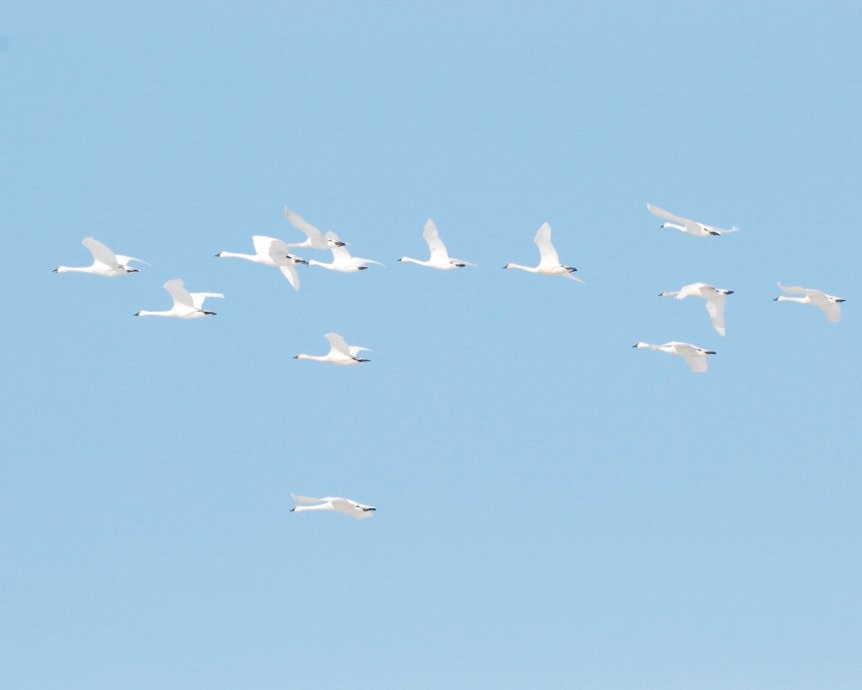In 1962 the state of Utah initiated a most unique hunting opportunity. To the bag of ducks and geese was added the chance to hunt what was then commonly referred to as the “whistling” swan. Now known as the tundra swan, the earlier name made note of the sound produced by the birds’ wings and apparently originated with Meriwether Lewis.
My first experience with Cygnus columbianus occurred back in the ’70s when I was in high school. During Christmas vacation my dad and I went out hunting with his law partner. None of us had any experience hunting swans. We hoped to get lucky and get a chance at the birds while we were hunting for ducks.
The day was gray and cold. The narrow hull of the “newstate-style” duck boat cracked through the ice as we cleared a place for our decoys. Whether we saw or shot anything else that day, all I remember is a great gray bird turning away from me and, then, placing the bead of my Ithaca side-by-side in front of the long neck and pulling the trigger. Both barrels fired simultaneously—the only time in 40 years that’s ever happened—sending a double load of lead No. 5s skyward.
Pride doesn’t adequately describe how I felt carrying that bird back to the boat. My dad still talks about that shot.
With my own son now, I hope to give him the same chance to experience the emotion and adrenaline of hunting these beautiful birds.
First step: apply for a permit.
In Utah, as in other swan hunting states, the privilege of pursing a swan starts with applying for the permit. The first state in the Pacific Flyway to initiate a swan hunt, Utah now offers 2,000 hunters the chance to draw a permit to hunt this graceful, snow-white trophy. Approximately 6,000 hunters apply annually, so your opportunity to hunt comes around every two or three years.
However, in Nevada, where 605 permits are allocated, only 404 permits were sold last year, according to Russell Woolstenhulme, Migratory Game Bird Staff Biologist for the Nevada Department of Wildlife.
The primary reason for the permit process is to protect the trumpeter swan. By the 1920s, trumpeter swans had nearly been wiped out by the market for their feathers and meat. The Migratory Bird Treaty Act of 1918 began the process of restoring many species, including trumpeters. Trumpeters continue a strong recovery, yet they remain threatened in parts of their range.
Trumpeters will travel with tundra swans and, therefore, face the risk of being taken by hunters. Given the difficulty of distinguishing one all-white bird from another, state agencies employ various means to protect trumpeters. Utah, along with Nevada and other states, enforce regulations that require any successful hunter to have their swan checked by a qualified biologist within 72 hours. Each swan’s bill is measured—the easiest way to distinguish trumpeters from tundras. A bill over 62 millimeters means the bird is a trumpeter swan.

Think you can tell, for certain, whether these are tundra or trumpeter swans? Educational programs across the country aim to teach you just that. (Photo: Alan Peterson)
There are other, more subtle ways of identifying the right bird. Trumpeters are larger than tundras. Trumpeters also have a square head, whereas tundras are round. Trumpeters have black lores (the portion of the head between the eye and beak), while tundras often have a yellow spot on the lores.
These small details make all the difference in the world. In Utah, if ten harvested swans are identified as trumpeters, the hunt is immediately suspended.
“The hunt has never been cancelled, nor has it been cut short due to us reaching our trumpeter swan quota of ten birds,” says Blair Stringham, Migratory Game Bird Program Coordinator for the Utah Division of Wildlife Resources. Likewise, in Nevada, the hunt has never been suspended by reaching the Nevada five-bird quota, according to Woolstenhulme.
One of the reasons for success are programs like Utah’s Swan Hunter Orientation Course that must be passed with 100 percent accuracy before a hunter can apply for a permit. The course covers history, rules of the hunt, and, most importantly, how to identify the four different types of swans that might be encountered in the Utah marshes.
“The swan orientation course has been very successful . . . several other states, including Montana, [which] has a large trumpeter population, also refer their hunters to our site,” Stringham adds. “It likely has helped hunters avoid shooting trumpeters there.”
Having passed the orientation course and made our application, we anxiously waited for notification of our success or failure in drawing a permit . . .
Stay tuned to SCD for more on Peterson’s swan hunting adventure.

